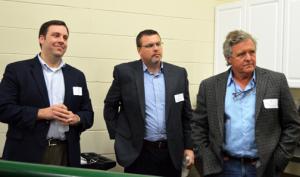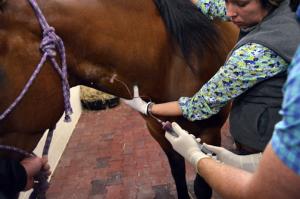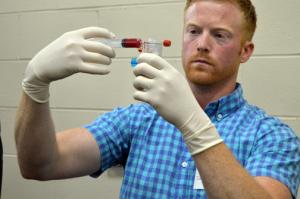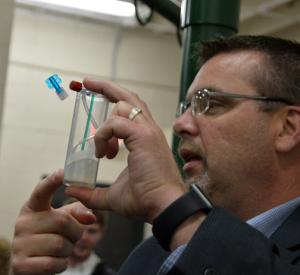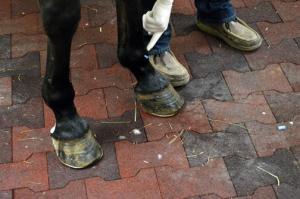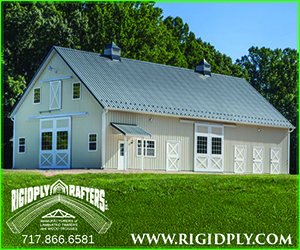By Nancy Brannon, Ph.D.
Both Tennessee Equine Hospital (TEH) locations held community forums April 13 and 14, 2016 to introduce horse owners to Owl Manor Veterinary’s products in Regenerative Medicine. Attendees were first treated to dinner. In Eads, TN it was traditional Memphis-style barbeque. About 70 people attended the Thompson’s Station, TN event, and about 40 people attended the Eads, TN event.
With a welcome and brief introduction from TEH’s Dr. Monty McIntuff, attendees were introduced to the representatives from Own Manor Veterinary, who explained their three regenerative therapy products: Mark Schindel, Chief Executive Officer; Mike Leach, Chief Operating Officer; William King, Ph.D., research scientist. Dr. McInturff referred to Regenerative Medicine as “the most innovative treatment we’ve had in my 27 years practicing” veterinary medicine. Following the presentation from Owl Manor Veterinary, Tennessee Equine veterinarian Dr. Zach Bruggen demonstrated the Pro-Stride™ injection, administered to a reining horse at the clinic who has fetlock arthritis in both front legs.
Clarification of terms.
Autologous refers to cells or tissues obtained from the same individual. Owl Manor Veterinary (OMV) has trademarked the term Autologous Cellular Therapy (ACT™) for their portfolio of regenerative biologic products. Owl Manor suggested, “Stem cells, platelets, and growth factors are central to joint treatment and would healing.”
IRAP refers to Interleukin 1 receptor antagonist protein, which is a natural anti-inflammatory protein released by leukocytes at the site of an injury. This protein is collected from blood by processing the leukocytes using a proprietary method. IRAP counteracts inflammation by blocking the inflammatory protein interleukin-1 within joints, where if unblocked, can lead to pain and damage.
Mesenchymal Stem Cells (MSC) are multipotent stromal cells that can differentiate into a variety of cell types, including bone cells, cartilage cells, muscle cells, and fat cells. MSCs have a great capacity for self-renewal while maintaining their multipotency. MSCs are adult stem cells that are commonly found in the bone marrow.
Platelets are a component of blood whose function (along with the coagulation factors) is to stop bleeding by clumping and clotting blood vessel injuries. Platelets have no cell nucleus; they are fragments of cytoplasm that are derived from bone marrow megakaryocytes – large bone marrow cells with a lobulated nucleus responsible for the production of blood platelets, aka thrombocytes.
Mark Schindel, Chief Executive Officer of OMV, explained that their products use the body’s own mechanisms (blood or cells) to heal joints, ligaments, and tendon injuries. All are point-of-care treatments that can be done in about 30 minutes or less.
Schindel emphasized that point of care matters greatly, because time is of the essence. “Early treatment yields better results,” and these therapies are done quickly and efficiently.
Dr. Bruggen said that point of care could be the horse’s own barn, but it is better done in a veterinary clinic where one can be assured of the cleanliness of the environment. “Being in a clean environment is very important!” he emphasized.
Schindel explained their three treatment products. (1) Pro-Stride™ Injection is an anti-inflammatory with IRAP; (2) ACT-PRP is a white blood cell (leukocyte) rich Platelet Rich Plasma (PRP) - noting that white blood cells are the mediators of the immune system; and (3) ACT-Cell Concentration (BMA) is a Mesenchymal Stem Cell therapy taken from bone marrow aspirate. All three products use the patient’s own cells – blood or bone marrow – that are processed through a centrifuge into a highly concentrated form, and then injected back into the patient at the point of injury for expedited healing.
Research scientist William King, Ph.D. said the goal of regenerative medicine is “to restore damaged or diseased tissue.” He explained in detail how the process works, using the analogy of a pyramid to relate the three elements of Regenerative Medicine. Cellular Source is at the top of the pyramid. “Most adult tissues contain cells that can regenerate a variety of tissue structures.” But these cells need Signals telling them what to do. “Stem cells are the building blocks of tissue regeneration, but they need a plan. The plan comes from soluble Signals, such as growth factors, which orchestrate tissue regeneration. Platelets guide the initial steps, and PRP can ‘jump-start’ healing in acute injuries.” Finally, the regenerative cells need a Scaffold on which to build the work of regeneration. Matrix proteins, such as collagen and fibrin, form continuous porous networks along which the cells grab hold and pull themselves along. Fibrin comes from the plasma, the liquid part of blood, when activated by the platelets. Therefore, PRP contains the matrix proteins and the signals to form” the Scaffold on which the cells rebuild, or regenerate.
Dr. McInturff added his personal insight to King’s presentation. “The body heals itself. But sometimes the body doesn’t heal. Why is that? Two main reasons: inadequate blood supply or infection. Tendons and ligaments heal very slowly because they have low blood supply. With the use of PRP, we’re seeing tendons heal 60% faster than they normally did.
“These are drug-free, durable therapies,” McInturff and King emphasized. “One PRP injection has a sustained effect. In 30 days we can see healing from one injection. We can follow up with shock wave therapy to further stimulate the cells to ‘get to work,’ and then follow up in 30 days with ultrasound to check the progress,” McInturff said.
Pro-Stride Injection™ is used for joint therapy, as an alternative to more traditional methods of injecting joints, e.g., hocks, with hyaluronate sodium (Legend®), polysulfated glycosaminoglycan (Adequan®) or corticosteroids.
The Pro-Stride™ method derives ~60 ml of blood from the horse (mixed with anti-coagulant at time of the blood draw) which is put into a specially made plastic device; run through the centrifuge at 3200 rpm for 15 minutes; the liquid part on the top is removed. The remaining concentrated fraction is extracted and placed into a second device. This is run through the centrifuge at 2,000 rpm for 2 minutes, allowing for greater concentration of the cells, platelets, growth factors, and anti-inflammatory proteins. The final output is put into a syringe for injection into the affected joint(s). To see a video of the process, go to: http://www.omveterinary.com/#!pro-stride/c111g
“This product manages pain and heals the joint at the same time,” Dr. McInturff interjected. The high concentration of platelets originally captured supports greater concentration of anti-inflammatory proteins, which block the inflammatory proteins and promotes healing.
The ACT-Cell Concentrate Bone Marrow Aspirate (BMA) “isolates stem cells from bone marrow in about 15 minutes,” King explained. The bone marrow contains Mesenchymal stem cells which form a variety of types of cells. Again, this is done at point of care. The cells are harvested from the sternum and/or the iliac crest bones. The concentration of cells is what matters. And the increased concentration of cells is ten-fold in this product.”
Dr. McInturff asked if anyone wondered about the cost? Cost of the Pro-Stride treatment is around $600, he said, which should be compared to the cost of multiple injections of other products. These [regenerative medicine] products, he said, have much longer term effects.
While Owl Manor Veterinary has only been selling these products for the past 15 months, Mike Leach, Chief Operating Officer, said they have over 16 years in developing these products. Find more information at: http://www.omveterinary.com/
Both Tennessee Equine Hospital (TEH) locations held community forums April 13 and 14, 2016 to introduce horse owners to Owl Manor Veterinary’s products in Regenerative Medicine. Attendees were first treated to dinner. In Eads, TN it was traditional Memphis-style barbeque. About 70 people attended the Thompson’s Station, TN event, and about 40 people attended the Eads, TN event.
With a welcome and brief introduction from TEH’s Dr. Monty McIntuff, attendees were introduced to the representatives from Own Manor Veterinary, who explained their three regenerative therapy products: Mark Schindel, Chief Executive Officer; Mike Leach, Chief Operating Officer; William King, Ph.D., research scientist. Dr. McInturff referred to Regenerative Medicine as “the most innovative treatment we’ve had in my 27 years practicing” veterinary medicine. Following the presentation from Owl Manor Veterinary, Tennessee Equine veterinarian Dr. Zach Bruggen demonstrated the Pro-Stride™ injection, administered to a reining horse at the clinic who has fetlock arthritis in both front legs.
Clarification of terms.
Autologous refers to cells or tissues obtained from the same individual. Owl Manor Veterinary (OMV) has trademarked the term Autologous Cellular Therapy (ACT™) for their portfolio of regenerative biologic products. Owl Manor suggested, “Stem cells, platelets, and growth factors are central to joint treatment and would healing.”
IRAP refers to Interleukin 1 receptor antagonist protein, which is a natural anti-inflammatory protein released by leukocytes at the site of an injury. This protein is collected from blood by processing the leukocytes using a proprietary method. IRAP counteracts inflammation by blocking the inflammatory protein interleukin-1 within joints, where if unblocked, can lead to pain and damage.
Mesenchymal Stem Cells (MSC) are multipotent stromal cells that can differentiate into a variety of cell types, including bone cells, cartilage cells, muscle cells, and fat cells. MSCs have a great capacity for self-renewal while maintaining their multipotency. MSCs are adult stem cells that are commonly found in the bone marrow.
Platelets are a component of blood whose function (along with the coagulation factors) is to stop bleeding by clumping and clotting blood vessel injuries. Platelets have no cell nucleus; they are fragments of cytoplasm that are derived from bone marrow megakaryocytes – large bone marrow cells with a lobulated nucleus responsible for the production of blood platelets, aka thrombocytes.
Mark Schindel, Chief Executive Officer of OMV, explained that their products use the body’s own mechanisms (blood or cells) to heal joints, ligaments, and tendon injuries. All are point-of-care treatments that can be done in about 30 minutes or less.
Schindel emphasized that point of care matters greatly, because time is of the essence. “Early treatment yields better results,” and these therapies are done quickly and efficiently.
Dr. Bruggen said that point of care could be the horse’s own barn, but it is better done in a veterinary clinic where one can be assured of the cleanliness of the environment. “Being in a clean environment is very important!” he emphasized.
Schindel explained their three treatment products. (1) Pro-Stride™ Injection is an anti-inflammatory with IRAP; (2) ACT-PRP is a white blood cell (leukocyte) rich Platelet Rich Plasma (PRP) - noting that white blood cells are the mediators of the immune system; and (3) ACT-Cell Concentration (BMA) is a Mesenchymal Stem Cell therapy taken from bone marrow aspirate. All three products use the patient’s own cells – blood or bone marrow – that are processed through a centrifuge into a highly concentrated form, and then injected back into the patient at the point of injury for expedited healing.
Research scientist William King, Ph.D. said the goal of regenerative medicine is “to restore damaged or diseased tissue.” He explained in detail how the process works, using the analogy of a pyramid to relate the three elements of Regenerative Medicine. Cellular Source is at the top of the pyramid. “Most adult tissues contain cells that can regenerate a variety of tissue structures.” But these cells need Signals telling them what to do. “Stem cells are the building blocks of tissue regeneration, but they need a plan. The plan comes from soluble Signals, such as growth factors, which orchestrate tissue regeneration. Platelets guide the initial steps, and PRP can ‘jump-start’ healing in acute injuries.” Finally, the regenerative cells need a Scaffold on which to build the work of regeneration. Matrix proteins, such as collagen and fibrin, form continuous porous networks along which the cells grab hold and pull themselves along. Fibrin comes from the plasma, the liquid part of blood, when activated by the platelets. Therefore, PRP contains the matrix proteins and the signals to form” the Scaffold on which the cells rebuild, or regenerate.
Dr. McInturff added his personal insight to King’s presentation. “The body heals itself. But sometimes the body doesn’t heal. Why is that? Two main reasons: inadequate blood supply or infection. Tendons and ligaments heal very slowly because they have low blood supply. With the use of PRP, we’re seeing tendons heal 60% faster than they normally did.
“These are drug-free, durable therapies,” McInturff and King emphasized. “One PRP injection has a sustained effect. In 30 days we can see healing from one injection. We can follow up with shock wave therapy to further stimulate the cells to ‘get to work,’ and then follow up in 30 days with ultrasound to check the progress,” McInturff said.
Pro-Stride Injection™ is used for joint therapy, as an alternative to more traditional methods of injecting joints, e.g., hocks, with hyaluronate sodium (Legend®), polysulfated glycosaminoglycan (Adequan®) or corticosteroids.
The Pro-Stride™ method derives ~60 ml of blood from the horse (mixed with anti-coagulant at time of the blood draw) which is put into a specially made plastic device; run through the centrifuge at 3200 rpm for 15 minutes; the liquid part on the top is removed. The remaining concentrated fraction is extracted and placed into a second device. This is run through the centrifuge at 2,000 rpm for 2 minutes, allowing for greater concentration of the cells, platelets, growth factors, and anti-inflammatory proteins. The final output is put into a syringe for injection into the affected joint(s). To see a video of the process, go to: http://www.omveterinary.com/#!pro-stride/c111g
“This product manages pain and heals the joint at the same time,” Dr. McInturff interjected. The high concentration of platelets originally captured supports greater concentration of anti-inflammatory proteins, which block the inflammatory proteins and promotes healing.
The ACT-Cell Concentrate Bone Marrow Aspirate (BMA) “isolates stem cells from bone marrow in about 15 minutes,” King explained. The bone marrow contains Mesenchymal stem cells which form a variety of types of cells. Again, this is done at point of care. The cells are harvested from the sternum and/or the iliac crest bones. The concentration of cells is what matters. And the increased concentration of cells is ten-fold in this product.”
Dr. McInturff asked if anyone wondered about the cost? Cost of the Pro-Stride treatment is around $600, he said, which should be compared to the cost of multiple injections of other products. These [regenerative medicine] products, he said, have much longer term effects.
While Owl Manor Veterinary has only been selling these products for the past 15 months, Mike Leach, Chief Operating Officer, said they have over 16 years in developing these products. Find more information at: http://www.omveterinary.com/
